
Jan 3
/
Alef Dias
Grains, Oilseeds and Livestock Weekly Report - 2024 01 03
Back to main blog page
Wheat: Russian fundamentals continue to put pressure on the market
•A
new year is beginning, but Russia continues to bring bearish fundamentals to
the wheat markets.
•The weather has been improving for the new Russian winter crop for several months now. At this stage, everything is pointing to a total production of over 90M mt.
•Looking at the demand side, some of the main destinations seem to be sensitive to price variations, which limits the upward potential.
•Shipments at Russian ports in December slowed down compared to the fall, and sales of Russian wheat decreased at the end of the month.
•The weather has been improving for the new Russian winter crop for several months now. At this stage, everything is pointing to a total production of over 90M mt.
•Looking at the demand side, some of the main destinations seem to be sensitive to price variations, which limits the upward potential.
•Shipments at Russian ports in December slowed down compared to the fall, and sales of Russian wheat decreased at the end of the month.
Introduction
A new year is beginning, but an old theme is likely to continue to put pressure on the wheat markets throughout 2024: the supply of Russian wheat. So far we have several indications of another large winter harvest in the country, and the reduction in foreign purchases of Russian wheat as a result of "artificially" higher prices also shows a weakness in demand.
New crop, same story
Weather conditions in most winter wheat regions are favorable for the crop's development. In the last 60 days, rainfall has exceeded 200% of normal, improving soil moisture in the South and establishing sufficient snow cover in other areas.
The condition of winter crops is better than average. According to the Russian Hydro-Meteorological Center, only 4% of winter crops were in poor condition at the end of November, compared to a five-year average of 8%. Conditions have probably improved further in recent weeks amid favorable weather.
The condition of winter crops is better than average. According to the Russian Hydro-Meteorological Center, only 4% of winter crops were in poor condition at the end of November, compared to a five-year average of 8%. Conditions have probably improved further in recent weeks amid favorable weather.
Fig. 1: Production, Domestic Use and Exportable Surplus - Wheat Russia (M mt)
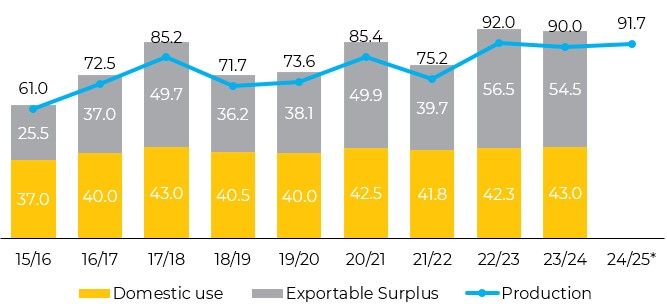
Source: USDA.*24/25 considering SovEcon's estimates
Fig. 2: Rainfall over the last 60 days (% of normal - wheat production shown internally)
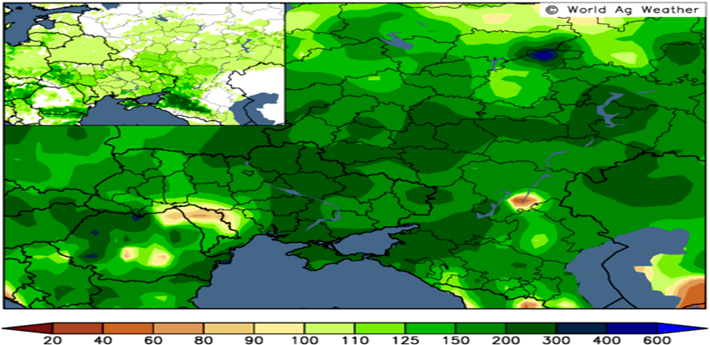
Source: WorldAgWeather
Weather models for the next two weeks predict ample rainfall and temperatures several degrees above average in most winter wheat-growing regions.
The weather has been improving for the new Russian winter crop for several months now. At this stage, everything is pointing to a total production of over 90M mt. If there are no major weather anomalies, this could start to put pressure on global wheat prices in the second half of Q1 2024.
Fig. 3: Soil moisture in the root zone of Southern Russia (% within the top 1 meter)
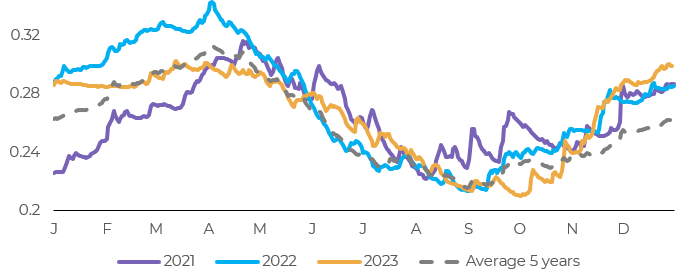
Source: Refinitiv
Fig. 4: Temperature anomaly - Next 15 days (ºC of normal)

Source: NOAA, hEDGEpoint
Demand likely will not match the minimum price
Shipments at Russian ports in December slowed down compared to the fall. Wheat exports totaled 2.0M mt in the first three weeks of December, compared to 2.3M mt in November and 2.7M mt in October.
Sales of Russian wheat decreased at the end of the month. The amount of outstanding Russian wheat sales on December 27 was 2.9M mt, down from 3.3M mt at the beginning of the month.
Shipments are likely to be limited by the Russian Ministry of Agriculture's (AgMin) attempts to regulate wheat prices. In Egypt's last two GASC tenders (the last one having been canceled last week), Russian suppliers were unanimous in offering wheat at $265/mt. These offers are probably in line with the "recommended minimum price" set by AgMin, as reported by Russian media.
In December, SovEcon (a consultancy specialized in the Russian market) reduced its estimate for Russian wheat exports in 2023/24 by 0.2M mt to 48.6M mt. The USDA maintained its estimate at 50.0M mt. Considering the current market dynamics, the latest estimate is starting to look overly optimistic.
In December, SovEcon (a consultancy specialized in the Russian market) reduced its estimate for Russian wheat exports in 2023/24 by 0.2M mt to 48.6M mt. The USDA maintained its estimate at 50.0M mt. Considering the current market dynamics, the latest estimate is starting to look overly optimistic.
Fig. 5: Monthly exports by ship - Wheat Russia (M mt)
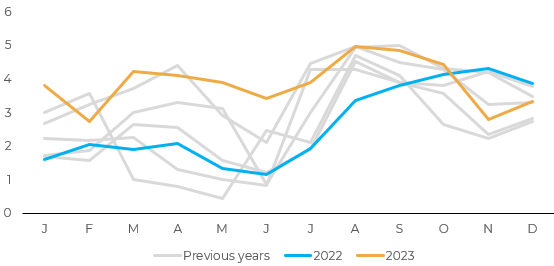
Source: Refinitiv
In summary
Recent fundamentals from the Russian market should continue to exert downward pressure on wheat prices. Looking at the demand side, some of the main destinations seem to be sensitive to price variations, which limits the upward potential - especially in North Africa. On the supply side, conditions remain very positive for the winter crop in Russia, which is on track for another total production (winter + spring) of 90M mt.
Fig. 6: FOB wheat prices - Europe and the Black Sea (USD/ton)
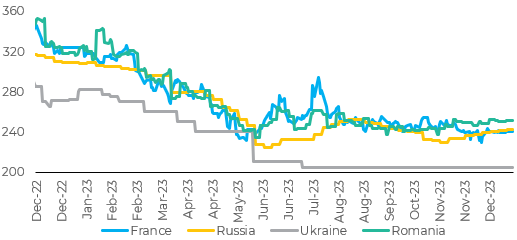
Source: Refinitiv
Weekly Report — Grains and Oilseeds
Written by Alef Dias
alef.dias@hedgepointglobal.com
Reviewed by Pedro Schicchi
pedro.schicchi@hedgepointglobal.com
pedro.schicchi@hedgepointglobal.com
www.hedgepointglobal.com
Disclaimer
This document has been prepared by hEDGEpoint Global Markets LLC and its affiliates ("HPGM") exclusively for informational and instructional purposes, without the purpose of creating obligations or commitments with third parties, and is not intended to promote an offer, or solicitation of an offer, to sell or buy any securities or investment products. HPGM and its associates expressly disclaim any use of the information contained herein that may result in direct or indirect damage of any kind. If you have any questions that are not resolved in the first instance of contact with the client (client.services@hedgepointglobal.com), please contact our internal ombudsman channel (ouvidoria@hedgepointglobal.com) or 0800-878-8408 (for clients in Brazil only).
Contact us
hedgepointhub.support@hedgepointglobal.com
ouvidoria@hedgepointglobal.com
Funchal Street, 418, 18º floor - Vila Olímpia São Paulo, SP, Brasil
Check our general terms and important notices.
This page has been prepared by Hedgepoint Schweiz AG and its affiliates (“Hedgepoint”) solely for informational and instructional purposes, without the purpose of instituting obligations or commitments to third parties, nor is it intended to promote an offer, or solicitation of an offer of sale or purchase relating to any securities, commodities interests or investment products. Hedgepoint and its associates expressly disclaim any use of the information contained herein that directly or indirectly result in damages or damages of any kind. Information is obtained from sources which we believe to be reliable, but we do not warrant or guarantee the timeliness or accuracy of this information. The trading of commodities interests such as futures, options, and swaps involves substantial risk of loss and may not be suitable for all investors. You should carefully consider wither such trading is suitable for you in light of your financial condition. Past performance is not necessarily indicative of future results. Customers should rely on their own independent judgement and/or advisors before entering in any transaction.Hedgepoint does not provide legal, tax or accounting advice and you are responsible for seeking any such advice separately.Hedgepoint Schweiz AG is organized, incorporated, and existing under the laws of Switzerland, is filiated to ARIF, the Association Romande des Intermédiaires Financiers, which is a FINMA-authorized Self-Regulatory Organization. Hedgepoint Commodities LLC is organized, incorporated, and existing under the laws of the USA, and is authorized and regulated by the Commodity Futures Trading Commission (CFTC) and a member of the National Futures Association (NFA) to act as an Introducing Broker and Commodity Trading Advisor. HedgePoint Global Markets Limited is Regulated by the Dubai Financial Services Authority. The content is directed at Professional Clients and not Retail Clients. Hedgepoint Global Markets PTE. Ltd is organized, incorporated, and existing under the laws of Singapore, exempted from obtaining a financial services license as per the Second Schedule of the Securities and Futures (Licensing and Conduct of Business) Act, by the Monetary Authority of Singapore (MAS). Hedgepoint Global Markets DTVM Ltda. is authorized and regulated in Brazil by the Central Bank of Brazil (BCB) and the Brazilian Securities Commission (CVM). Hedgepoint Serviços Ltda. is organized, incorporated, and existing under the laws of Brazil. Hedgepoint Global Markets S.A. is organized, incorporated, and existing under the laws of Uruguay. In case of questions not resolved by the first instance of customer contact (client.services@Hedgepointglobal.com), please contact internal ombudsman channel (ombudsman@hedgepointglobal.com – global or ouvidoria@hedgepointglobal.com – Brazil only) or call 0800-8788408 (Brazil only).Integrity, ethics, and transparency are values that guide our culture. To further strengthen our practices, Hedgepoint has a whistleblower channel for employees and third-parties by e-mail ethicline@hedgepointglobal.com or forms Ethic Line – Hedgepoint Global Markets.Security note: All contacts with customers and partners are conducted exclusively through our domain @hedgepointglobal.com. Do not accept any information, bills, statements or requests from different domains and pay special attention to any variations in letters or spelling, as they may indicate a fraudulent situation.“HedgePoint” and the “HedgePoint” logo are marks for the exclusive use of HedgePoint and/or its affiliates. Use or reproduction is prohibited, unless expressly authorized by HedgePoint. Furthermore, the use of any other marks in this document has been authorized for identification purposes only. It does not, therefore, imply any rights of HedgePoint in these marks or imply endorsement, association or seal by the owners of these marks with HedgePoint or its affiliates.
We have updated our Terms & Conditions to reflect improvements to our platform, data handling practices, and the overall experience we provide to our clients.
To continue using the Hedgepoint HUB, please review and accept the updated terms.

